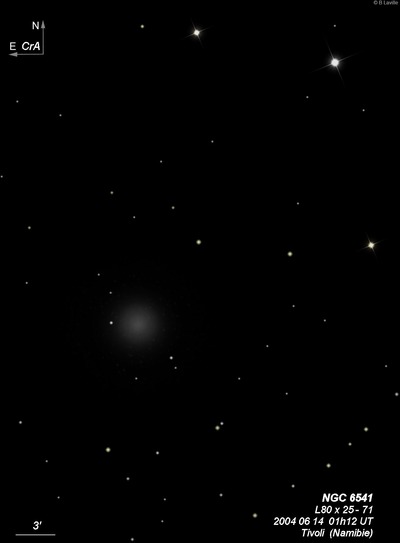
Niccolo Cacciatore, an assistant to Giuseppe Piazzi at Palermo, discovered NGC 6541 = D 473 = h 3726 on 19 Mar 1826, while searching for Comet C/1825 N1 (Pons) with a small refractor. James Dunlop independently discovered this globular a few months later on 3 Jul 1826 and described "a very bright round highly condensed nebula, about 3' diameter. I can resolve a considerable portion round the margin, but the compression is so great near the centre, that it would require a very high power, as well as light, to separate the stars; the stars are rather dusky." He notes 5 observations were made and his position is 6' northwest of the center. John Herschel's first observation was on 1 Jun 1834 (h3726) and he reported "globular, B, R, e comp, v Fine; diameter of most comp part = 11 seconds of time in RA; stars 15..16m. The scattered stars extend to three times the diameter and die away very gradually." He references D 473 in the Cape catalogue but wasn't aware of Cacciatore's earlier observation.
200/250mm - 8" (7/16/82): bright, fairly small, well concentrated to bright core. Mottled halo but no resolution. Located 20' SE of a mag 5 star (h 5014 = 5.8/5.8 at 1.8"). Very far south (low elevation) for viewing from Northern California.
400/500mm - 18" (7/9/02 - Magellan Observatory, Australia): this beautiful globular is set in a rich star field and is strongly compressed with a blazing core. At 171x, the halo is ~8' and highly resolved into a couple of hundred stars mag 12 and fainter. A few brighter stars (field?) are mixed in, including mag 11 stars on the east and southwest side of the halo. The stars are densely packed towards the core - another southern showpiece globular!
Notes by Steve Gottlieb